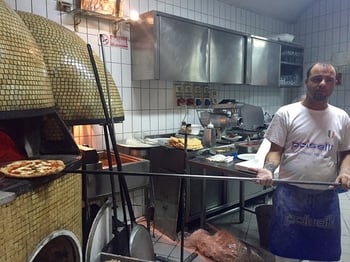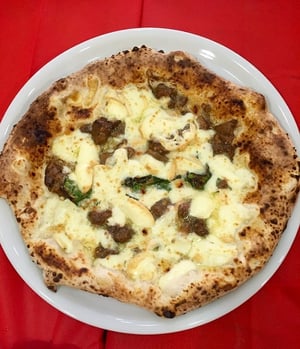LIM COLLEGE FACULTY BLOG
In Naples: Enjoy the Pizza. Skip the Ice.
posted by Fred Steinberg, Adjunct Faculty in Marketing, Management & Finance
Enjoy the pizza
 There are many good reasons to go to Italy and among them is visiting Naples. This city is billed as home to more historic monuments than any other city in Europe and is just an hour from the magnificent ruins of Pompeii.
There are many good reasons to go to Italy and among them is visiting Naples. This city is billed as home to more historic monuments than any other city in Europe and is just an hour from the magnificent ruins of Pompeii.
But for foodies, Naples is also Mecca for pizza lovers. And while some Israeli historians claim pizza evolved from a time 2,000 years ago when Roman soldiers added cheese and olive oil to matzos and certain Chinese scholars ascribe to the theory that Marco Polo brought pizza back from the Hidden Kingdom during his travels, most historians believe that Naples gets the credit when in the mid-19th century tomatoes and olive oil were added to a Neapolitan galette flatbread often known as “pizza,” a street dish originally sold for just a few lira.
In 1889, to honor the Queen consort of Italy, Margherita of Savoy, Pizza Margherita, a pie garnished with tomatoes, mozzarella and basil, representing the colors on the Italian flag, was introduced. This would be the version that first migrated to the U.S. with the wave of Italian immigrants arriving in Boston at the dawn of the 20th Century and shortly after in New York, Philadelphia and St. Louis. Pizza’s migration across the country ended in L.A. with the D’Amore’s family pizzeria’s opening in 1939.
 As dedicated foodies who had never been to Naples, we headed to this fabled city in Southern Italy which traces its history back to the Bronze Age. For in addition to being almost universally now recognized as where pizza originated, the city is home to more Michlin Guide rated restaurants than any other in Italy and we were determined to find the oldest and best pizza emporiums in town.
As dedicated foodies who had never been to Naples, we headed to this fabled city in Southern Italy which traces its history back to the Bronze Age. For in addition to being almost universally now recognized as where pizza originated, the city is home to more Michlin Guide rated restaurants than any other in Italy and we were determined to find the oldest and best pizza emporiums in town.
We departed the train from Rome at the central terminal in Piazza Garibaldi, the heart of Naples’s “Pizzaland,” and, as previously advised, spotted our hotel, the UNA Napoli, perfectly located just across the square. That meant the hotel was within easy walking distances of our pizza targets. The hotel met our needs perfectly – well-apportioned rooms, quiet, a very helpful front desk, and a great breakfast included at a reasonable price.
Since every Neapolitan seems to have his favorite pizzeria and many disagree on where the oldest and most authentic ones are, we hired a pizza specialist guide affiliated with the National Archeological Museum for a four-hour walking tour of the historic city center where the best pizzerias are located.
From late morning till mid-afternoon our most knowledgeably guide juxtaposed the outstanding sites including churches, small art museums, monuments, ancient streets, and other landmarks between three pizzeria stops representing open-air street, casual, and more formal dining pizzerias.
 Our first stop was at the fabled Antica Pizzeria Port’Alba, regarded as the oldest pizzeria in Italy and therefore in the world, dating back to the end of the 18th Century. We received a pizza making demonstration utilizing what is billed as the world’s oldest operating pizza oven. The resulting Margherita pizza was first rate.
Our first stop was at the fabled Antica Pizzeria Port’Alba, regarded as the oldest pizzeria in Italy and therefore in the world, dating back to the end of the 18th Century. We received a pizza making demonstration utilizing what is billed as the world’s oldest operating pizza oven. The resulting Margherita pizza was first rate.
After walking off our first pizza of the day for an hour around the historic district, we were treated to a sample of traditional “open air” or ”street pizza” which is sold from kiosks and pizzeria store fronts and is considered Italy’s premier fast food. In this version, a mini, rather thick pizza is wrapped in cone-shaped parchment, extremely easy to eat on the go. Until the early 19th Century, all pizza was sold this way and pizza was considered a food for the poor.
Finally, after touring for another hour, we stopped for a more formal lunch at Pizzeria Lombardi, which dates back 1895 and is known for its classic Neapolitan pizza which features a dark, crisp crust and local Buffalo Mozzarella cheese. It was the Lombardi family that first brought pizza to New York’s Little Italy just after the turn of the 19th Century.
After three pizza stops in four hours and two glasses of a fine local Falanghina white at Lombardi, we staggered back to our hotel, more than ready for an afternoon siesta. It was not however the end of our pizza hunt and in the next two days we dined at three other popular pizzerias, including one which served 21 varieties of pies – and nothing else except beverages.
Skip the Ice
After our final “pizzaless” morning in Naples, we boarded the train back to Rome for our flight home. When reaching to remove an item from the overhead rack, I banged my head and after sitting back in my seat i could feel a bump rising. There was an attendant on the train distributing beverages and newspapers and I had my wife ask her for some ice to put on my head when she next passed us. She directed my wife to the adjacent bar car where my wife asked the bartender for some ice in a napkin to ease my bump. Two uniformed attendants at the bar overheard her and returned to our seats with a large first aid kit containing a squeezable icepack which was just what I needed.
 The attendants then directed us to fill out a three-page accident form completely in Italian. With the help of one of the attendants, who spoke very limited English, we proceeded to spend some 20 minutes filling out the complex form. At the bottom of the last page where two paragraphs, one apparently absolving the railroad of responsibility for my accident and the other not absolving the railroad of responsibility.
The attendants then directed us to fill out a three-page accident form completely in Italian. With the help of one of the attendants, who spoke very limited English, we proceeded to spend some 20 minutes filling out the complex form. At the bottom of the last page where two paragraphs, one apparently absolving the railroad of responsibility for my accident and the other not absolving the railroad of responsibility.
The attendants' limited English was confusing and we incorrectly checked the “not absolving” line and I signed the forms. One quick look by the attendants and shortly we heard an announcement in Italian and English asking any doctors on the train to “come to carriage three.”
Three doctors quickly showed up. Two glanced at me and left and one, who spoke a little English, quickly examined me and then explained that we had checked the “railroad responsible” box and the train would be stopped at the next city where the police would take us by ambulance to a hospital.
We protested and with the help of an English-speaking passenger, told the attendants of our mistake and that we had no intention of getting off the train before Rome. Some 10 minutes and a number of phone calls later, the attendants agreed to have me “void” the first form by writing “agree to void” and signing each page. We then filled out a fresh form, making sure to check the “absolve the railroad from responsibility” paragraph. We held our breaths at the next stop but saw no police or ambulance at the station and proceeded to Rome for our flight home.
Lesson learned: Skip the ice on Italian railroads.